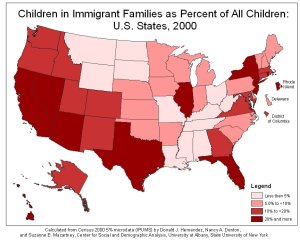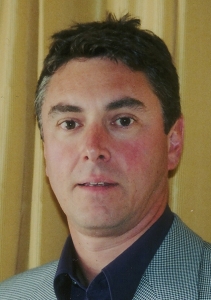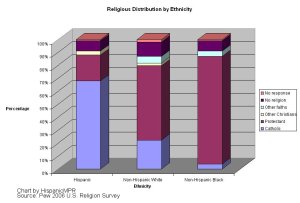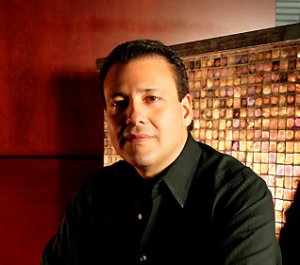Posted by Elena del Valle on July 20, 2007

Keeping the Faith cover
Photo: HarperCollins Publishers
In Keeping the Faith How Applying Spiritual Purpose to Your Work Can Lead to Extraordinary Success (Rayo, $22.95), Ana Mollinedo Mims describes how she arrived in the United States as a Cuban immigrant and eventually thrived in the corporate world. In the book, meant for anyone who has a job or hopes to be employed, she proposes to the reader that each struggle becomes an opportunity to grow spiritually, develop a purpose and achieve professional success. She believes that the answers we seek will reveal themselves more clearly and lead us to satisfaction through a blending of faith and work.
“My book is about developing a relationship with God that will lead to understanding one’s purpose and calling. I rarely talk about where I go to church because what is important is having the relationship not where you go to church. My book is not written from a denominational perspective and applies to everyone and anyone that has or is interested in developing a relationship with God regardless of where they go to church. God is the God of all not just one race or culture and I believe loves us all equally,” said Mollinedo Mims. “I was recently interviewed by Club 700 Hoy, the Hispanic version of the 700 Club and the response there was awesome. There are not many Hispanics, and specifically female Hispanics for the matter speaking about faith and how it applies to the workplace and to career development. So the response from all has been very rewarding.”
In Keeping the Faith, Mollinedo Mims, chief corporate communication officer, Cable & Wireless, Americas & Caribbean, discusses seven principles, faith, integrity, humility, prayer, forgiveness, stewardship, and legacy. The 256-page hardcover book is divided into three parts: Rebirth, Principles of the Spirit Led Career and On Reflection.
Mollinedo Mims has held executive positions with Fortune 500 companies and non profit organizations in strategic development, communications, media and corporate relations, government and investor relations, and website design. Prior to working with Cable & Wireless, she was global vice president of communications, Community Affairs & Diversity for Starwood Hotels & Resorts Worldwide, Inc.

Click here to purchase Keeping the Faith
Comments:
Filed Under: Books
Posted by Elena del Valle on July 19, 2007

David J. Perez, chief executive officer, Latin Force
Photo: Latin Force Group
New York, New York, – Latin Force LLC, a Hispanic marketing strategy firm, and Geoscape International Inc., a multicultural consumer intelligence and data analytics company, merged recently to form Latin Force Group. Existing staff will remain in place. The company plans to hire sales, finance and consulting staff.
The merger was made possible with the financial support of the Goldman Sachs Urban Investment Group (UIG). UIG is planning additional strategic investments in Hispanic marketing and related companies. Company representatives would not disclose the terms of the investment.
“The merged company will provide its existing and future customers with a clear competitive advantage in reaching America’s fastest growing demographic,” said Kevin Jordan, managing director, Goldman Sachs.
According to promotional materials, the new company provides integrated marketing services for over a quarter of the Fortune 100. Latin Force Group, with a staff of 30, will offer services and information to assist customers who want to identify and service ethnic consumers in financial, telecommunications, retail, insurance, health care, pharmaceuticals and consumer packaged goods. Latin Force Group clients include Allstate, Bank of America, Best Buy, Cranium, Direct TV, Epic Records, Humana, H&R Block, HSBC, ING, Kraft Foods, MTV, the NFL, Nickelodeon Networks, Toyota, Univision and Wells Fargo.
“This is an exciting first step in building out a full-service, integrated marketing company. The combination of Latin Force’s strategy consulting and Geoscape’s market intelligence data and systems form a unique and solid foundation for accelerated growth and future acquisitions,” said David J. Perez, chief executive officer of Latin Force.
Cesar Melgoza, managing director, Latin Force Group
The Latin Force Group will continue supporting Geoscape’s proprietary web-based platform, which draws upon database engines to reveal cultural attributes with dynamic segmentation, demographics and consumer spending data. Latin Force Group will operate from offices in Los Angeles, Miami and New York.
“Our industry leading products identify and segment customer data by ethnicity, acculturation, media preferences as well as consumer spending patterns,” said Cesar Melgoza, founder of Geoscape and now managing director of Latin Force Group.
The Goldman Sachs Urban Investment Group is part of the Merchant Banking Division of The Goldman Sachs Group, Inc. that invests capital in ethnic minority-owned or targeted businesses and urban real estate. Founded in 1869, Goldman Sachs is a leading global investment banking, securities and investment management firm. UIG makes corporate and real estate investments of $5 million to $50 million in various industries, project types, and financial structures.
Discover how to reach Latinos in language today with
“Hispanic Market Translation Issues” audio recording

Presenter Martha E. Galindo
Translation company owner Martha E. Galindo explains
-
Why it’s important to reach your clients in language
-
Ins and outs of translations issues
-
How to select a translator
-
What to expect
-
How to save on translation costs
-
Much more
Click here to purchase “Hispanic Market Translation Issues”
Posted by Elena del Valle on July 18, 2007

Click on image to enlarge
Images: Donald Hernandez, Ph.D
Washington, DC – Children in Immigrant Families: The U.S. and 50 States National Origins, Language and Early Education, a new research brief by Child Trends and the Center for Social and Demographic Analysis of the University at Albany, State University of New York, indicates that four of every 10 children in immigrant families have Mexican origins. Children with Mexican roots constitute the largest group of newcomers in 26 states.
The brief, authored by Donald J. Hernandez, Ph.D., Nancy A. Denton, Ph.D., and Nancy MacCartney, M.A., also indicates that 20 percent of children in the United States live with one foreign born parent. Four in five children are American citizens, three out of four speak English and nearly one-half speak English fluently and another language at home.
These findings led the researchers to conclude that children in immigrant families are deeply rooted in the United States. At the same time the researchers concluded that many young children in immigrant families would benefit from quality early education programs to further their integration into American society.

Donald Hernandez, Ph.D., professor and chair, Department of Sociology, University at Albany, SUNY
“These children represent a unique human resource for America. Investing now in early education and family literacy programs can help these children flourish,” said Hernandez, Ph.D., lead author of the brief. “Such investments will help to maximize the economic productivity of the next generation of workers who will support the soon-to-retire baby-boom generation. By developing strong language skills, these children can enhance the global economic and geopolitical positions of the U.S.”
While a state-by-state analysis on children in immigrant families revealed children whose families come from more than 125 countries and live in 50 states, 40 percent of children with immigrant parents have origins in Mexico. These children account for 50 percent to 81 percent of children in newcomer families in 12 states including Arizona, Arkansas, California, Colorado, Idaho, Illinois, Kansas, Nebraska, Nevada, and New Mexico, Oklahoma, and Texas. Children with other national origins are more likely to be found in the remaining states.
Child Trends is a nonprofit, nonpartisan research organization providing social science research to those who serve children and youth. Established in 1981, the Center for Social and Demographic Analysis (CSDA) at the University at Albany is dedicated to provide a strong research infrastructure for scholarship in the social sciences. It emphasizes support for interdisciplinary population research, especially the analysis of spatial inequalities and concerns for vulnerable.
“Latino Family Dynamics” audio recording


Brenda Hurley and Liria Barbosa
Discuss
Latino purchasing habits and products they favor
Latino family characteristics
Latinos and extended families
Division of duties, responsibilities within the family
Who is the decision maker in the Latino family
Who is the information provider in the Latino family
Click here to purchase “Latino Family Dynamics”
Posted by Elena del Valle on July 17, 2007
5th Annual Marketing Foods & Beverages to Hispanic Consumers conference

July 17-18, 2007
Chicago, IL
World Research Group is proud to present The 5th Annual Marketing Foods & Beverages to Hispanic Consumers Conference, taking place on July 17-18, 2007 at Chicago, IL. Don’t Miss this Ground-Breaking Conference with In-Depth Case Studies and Proven Marketing Strategies from Leading Food & Beverage Companies and Product Retailers including:
- Yolanda Angulo – Director of Multicultural Marketing from Kraft Foods North America
- Sunil Pande – Category Manager from Tyson Foods and
- Jose Serafin – Senior Brand Manager from The Coca –Cola Company
Join us and our expert speaking faculty and gain valuable insight into effective strategies for successfully connecting with Hispanic consumer audiences. Please register early as space is limited.
For more information and to register, please visit our website, http://www.worldrg.com/ or call 800-647-7600. Mention promo code: EBS778 to receive a $400 registration fee discount!
For details, visit http://worldrg.com/showConference.cfm?confcode=FW07052
Posted by Elena del Valle on July 17, 2007

The “Paparazzi” team from left to right, Alan Jacott, Daisy Ballmajó, Frank Cairo, Lourdes Ruiz Toledo and Allan Villafaña
Photo: MegaTV
Miami, FL – Miami station Mega TV’s “Paparazzi” show was so successful at the local level that it’s going national. Starting July 2, 2007, the SBS produced program began airing in other markets. “Paparazzi” will be syndicated across various television stations owned by Pappas Telecasting Companies, one of the largest privately-held commercial television broadcast groups in the United States.
“Paparazzi,” on the air since April 2006, offers viewers insights on celebrity lives accompanied by talent commentary. The show, hosted by Frank Cairo, airs every weekday for one hour at 7 p.m. Eastern, (5 p.m. Central, and 6 p.m. Pacific). He discusses each story with panelists Daisy Ballmajó, Alan Jacott, Lourdes Ruiz Toledo, and Allan Villafaña. Celebrities featured in past episodes include Ángel Lopez, Noelia, Celia Cruz, Roberto Carlos, Cristian Castro, Pepe Aguilar, Lupillo Rivera, Vicente Fernandez, Maria Conchita Alonso, and Victor Manuel.
Under the agreement, “Paparazzi” eventually will be televised on more than 20 Pappas television stations in California, Texas, Wisconsin, Iowa, Nebraska, Arizona, and Nevada, as Pappas Telecasting implements its new Spanish-language programming initiative. In California, Iowa, Nebraska, and Nevada, the show will available on KTNC-TV and KTNC-DT, which cover the San Francisco-Oakland-San Jose and Sacramento-Stockton-Modesto areas; KAZR-CA, in Reno, Nevada; KAZO, Omaha, Nebraska and KAZJ, Sioux City, Iowa will broadcast the program. Over the next six months, KFRE-CA in Fresno, KEAZ-LP in Eureka, and KBBV-CA in Bakersfield will be added.
In Texas, “Paparazzi” initially will appear on KAZH-TV and KAZH-DT in Houston, Texas. KXLK-CA in Austin, and KXCC-CA in Corpus Christi, Texas, WWAZ-TV and WWAZ-DT in Milwaukee, Wisconsin, will be added later in 2007. South of the border, viewers in Mexico also will be able to watch “Paparazzi” in a few months on KDBC-DT.3 in El Paso, Texas, which covers Juarez, Mexico, and KSWT-DT.3 from Yuma, Arizona, which reaches Mexicali, Mexico.
Pappas Telecasting Companies is one of the largest privately-held, commercial television broadcast groups in the United States in terms of U.S. household coverage as defined by Nielsen Media Research. The company owns 27 stations, including FOX, The CW, ABC, CBS, and MyNetworkTV affiliates, and operates four other stations. Additionally, Pappas owns 16 on-air digital channels, operates three others, and holds construction permits to build 10 additional television stations.
According to Nielsen statistics provided by the network, Pappas Telecasting television stations serve more than 16 percent of all U.S. television households. In addition, the company owns or operates television stations in markets reaching nearly 36 percent of U.S. Hispanic households and 38 percent of all U.S. Hispanics two and older.
Spanish Broadcasting System, Inc. is one of the largest publicly traded Hispanic-controlled media and entertainment companies in the United States. SBS owns and operates 20 radio stations located in Hispanic markets such as New York, Los Angeles, Miami, Chicago, San Francisco and Puerto Rico. The Company also owns and operates Mega TV in Miami.
“Latino Media and Hispanic Media Training” audio recording


Presenters Federico Suverbi, Ph.D. and Elena del Valle, MBA
Find out
• About the hundreds of Latino media
• Who are the major Hispanic media
• Type of media outlets they represent
• Languages in which they are produced
• Programming and content they offer
• Hispanic media geographic reach
• Hispanic media challenges
Click here to purchase ”Latino Media and Hispanic Media Training”
Posted by Elena del Valle on July 16, 2007

Los Bunkers
Photo: Nacional Records
Chilean rockers Los Bunkers released a “Live in Concert” DVD earlier this year. The album was recorded during the five-member band’s sold out show at the Teatro Teleton in Santiago, Chile. In addition to the DVD, the band’s record label Nacional Records, introduced an iTunes audio edition at the same time it released the DVD.
The DVD features live performances of Los Bunker’s U.S. radio hits like “Llueve Sobre la Ciudad,” “Ven Aquí” and “Ahora Que No Estás” as well as previous hits that were never released in the United States. The DVD also includes six music videos for “Ven Aquí”, “Llueve Sobre la Ciudad”, “Ahora que No Estás” and “Mientele” from the album “Vida de Perros,” and two videos from previous albums until now only seen in Chile.
Los Bunkers hit the U.S. scene last year with their North American debut “Vida de Perros.” At the same time, the album struck a chord among Mexican fans. In just the last year, Los Bunkers visited Mexico five times. Last year, the band also played at Vive Latino and they are slated to perform there again this year. “Ahora que no estás” has played on MTV Tr3s, LATV and mun2. Los Bunkers were nominated for Univision’s Premios Lo Nuestro for Best Rock Album.
Los Bunkers is made up of two sets of brothers and a friend: Gonzalo Lopez (bass), Mauricio Duran (guitar and vocals), Alvaro Lopez (vocals and acoustic guitar), Mauricio Basualto (drums) and Francisco Duran (guitars, keyboards, harmonica and vocals).
Los Bunkers was formed in 1999 in Concepcion, Chile. Later they moved to Santiago, Chile and released three albums, “Los Bunkers” (2001), “Cancion de Lejos” (2002) and “La Culpa” (2003) before signing to Nacional Records for their first U.S. release, “Vida de Perros.”
To listen to the single “Lueve Sobre la Ciudad (live)” from the “Live in Concert” album click the button to hear the podcast:
“Emotional Branding: How to capture the heart and mind of the Hispanic consumer” audio recording


“Emotional Branding” was recorded January 2007 during the Strategic Research Institute 13th Annual Blockbuster Marketing to U.S. Hispanic and Latin America conference in Miami, Florida. Receive a free downloadable copy by completing our Visitor Survey.
Click here to receive a free copy of Emotional Branding
Posted by Elena del Valle on July 13, 2007

Photo: Level 4 Press
Is Erik Rush a forward thinking problem solver or a land hungry imperialist? In the 220-page book Annexing Mexico: Solving the border problem through annexation and assimilation (Level 4 Press, $24.95) he shares his plans to take over Mexico in order to solve the United States Mexico immigration issues.
He argues that the 2,000 mile United States and Mexico border is more than just a boundary between nations; he sees it as a chasm that separates a wealthy global superpower from a poverty-stricken Third World Country. Perhaps, as he believes, the Mexico border has become a finish line for millions of Mexicans desperate for a better life. Instead of protecting the border, Rush says, get rid of it by absorbing the entire country.
“We’re like a dog chasing its tail,” said Rush. “We spend billions of dollars each year to keep immigrants out, then billions more on their education and healthcare once they get here anyway. We’d be smarter to spend those billions to improve and annex Mexico. We would solve the immigration problem and reap a host of other benefits.”
On the other hand, researchers point out that immigration from Mexico to the United States is past its peak and showing signs of slowing down further. They also say that the Mexican economy is likely to improve, reducing the desirability of northern migration.
Rush readily admits that a peaceful annexation of Mexico is a huge project that would require arduous political, economic and cultural work and years of integration. He points to polls that show 40 percent of Mexicans would like to live in America and 10 percent of Mexico’s population is already here. Would American’s ever agree to annex Mexico? How about Mexicans? Could it work? Would it matter that the reason Mexicans have migrated in the past is less relevant today and for years to come?

Click here to purchase Annexing Mexico
“Mexicans are generally a hard-working, family-oriented population,” said Rush. “Most Americans can appreciate those traits. The problem now is U.S. taxpayers are rightfully angry about carrying someone else’s load. The animosity will dissipate when the burden is shared equally by annexing Mexico and improving conditions there.”
Rush believes merging with the United States would bring health care benefits to Mexico, save American taxpayers $1.4 billion in emergency medical care to undocumented immigrants, and provide the combined country with energy independence thanks to Mexico’s oil reserves.
“Mexico has huge oil reserves that could eliminate our reliance on OPEC,” said Rush. “The state run oil business in Mexico operates at a loss right now, which is testament to the corruption in the Mexican government. There’s no excuse for this; it’s time for a dramatic change.”
Rush was born in New York City in 1961, the first child of a white father and a black mother. His family lived in the same neighborhood as Betty Shabazz, widow of slain civil rights activist Malcolm X, and her children. As a result he grew up keenly aware of the unfolding civil rights issues of the day. Rush has worked as a musician and a biomedical researcher.
In 1996, one of his short stories won a Chrysalis first place award for short fiction. His first novel, The Angels Fell, was released in 2002. Rush is a contributor of social commentary to WorldNetDaily and is a staff writer and acting associate editor and publisher for the New Media Alliance, Inc., a non-profit national coalition of writers, journalists and grass-roots media outlets.
Target Latinos effectively by anticipating changes in the market with
“Hispanic Projections” audio recording

Presenter Roger Selbert, Ph.D.
Find out
- About Latino buying power growth in the future
- How Latino market growth compares with other markets in the U.S.
- What drives the rise of Latino economic clout
- Who should target the Latino market
- What is the size of the Hispanic affluent market
- If the luxury Latino market is growing
- About Hispanics who earn more than $100,000 annually
Click here for details on “Hispanic Projections”
Comments:
Filed Under: Books
Posted by Elena del Valle on July 12, 2007
Joel “El Intruso” Santiago and Epi Colon, hosts, “El Jukeo”
Photo: WSKQ Mega 97.9 FM
Miami, Florida – “El Jukeo” of WSKQ Mega 97.9 FM, a Spanish Broadcasting Systems (SBS) evening four-hour radio show, reaches more than 600,000 Spanish language listeners aged 21 to 39 in New York City. Hosted by Joel “El Intruso” Santiago and Epi Colon, “El Jukeo” derives its name from an invented word in Puerto Rican slang which means to get hooked. “El Jukeo” receives higher ratings than any of the station’s other programs.
According to promotional materials, the made up word “Jukéate,” illustrates the producer’s desire to attract a large audience with its music and entertainment programming. “El Jukeo,” started in September 2006, airs Monday through Friday from 3 pm to 7 pm.
Prior to joining the New York station, Santiago worked at La Mega 106.9 FM in Puerto Rico, the sister station for La Mega 97.9 FM. He also worked for an English language music radio station.
“Joel was born and raised in New York. He knows the New York market,” said Jackie Torres, director of Marketing and Promotions for Mega 97.9 FM. “Epi also has an impressive background and worked for La Mega for two years before joining ‘El Jukeo.’ After those two years, he returned to Puerto Rico, but came back to La Mega for a chance to work with Joel. These two bright radio personalities have an incredible chemistry that allows them to work well together and attract a great audience.”
Colon began his career in radio in 1987 at WPAB 550 in Puerto Rico. He started at WPAB as promotions producer for station programs. After a few months, Colon was on the air as a DJ for Coqui FM Power 93, known then as “The Fat Rocker.”
In New York, he collaborated on the show “Vacilón de la Mañana” with Luis Jiménez on Mega 97.9 before returning to Puerto Rico as producer for “El Bayú” and “La Buya” for Mega 98.1 in Orlando. In January 2001, he returned to New York to co-host “La Buya” on 105.9 Latino Mix. A year later, Colon returned to Puerto Rico to work on “A To’ Fuete” on Salsoul with Luisa de Los Ríos, before returning to New York City.
Santiago began his career in 1996 with Sonocolor 97.7 FM in Puerto Rico. He continued to host in radio shows in Puerto Rico on stations Cosmos 94.7 FM, from 1997-2000, and Mega 106.9 FM.
In 2002, he made his acting debut in “Todo sobre mi pene” filmed in Puerto Rico. Two years later, he made an appearance in the Telemundo film “Encuentros.” That same year, Santiago started his career in television with Univision’s “Anda Pal Cará” in Puerto Rico. In 2005, he made another movie with Telemundo titled “La caja de problemas.”
“Latino Media and Hispanic Media Training” audio recording


Presenters Federico Suverbi, Ph.D. and Elena del Valle, MBA
Find out
• About the hundreds of Latino media
• Who are the major Hispanic media
• Type of media outlets they represent
• Languages in which they are produced
• Programming and content they offer
• Hispanic media geographic reach
• Hispanic media challenges
Click here to purchase ”Latino Media and Hispanic Media Training”
Posted by Elena del Valle on July 11, 2007
By Tony Malaghan, CEO, Arial International

Tony Malaghan, CEO, Arial International
Photo: Arial International
I recently read a research study by Javelin Strategy & Research titled, “Reaching Underbanked Latinos: Better Product and Sub-Segment Definition Required to Realize Growth and Retention”. Whilst the research is targeted at financial institutions, the findings are applicable across many industries.
The report, published in November 2006, combined research from interviews with large and small U.S. financial institutions regarding current strategies and best practices with quantitative research on banking habits of Latino consumers in the U.S. One of the key findings of the report is that 37 percent of Latino consumers actually switch banks because of dissatisfaction with customer service compared to 18 percent for the non-Latino market! In my view, that is a significant point of difference and one that every business targeting the U.S. Hispanic market needs to be cognizant.
Click here to read the complete article
Read Tony’s chapter on “Effective Translations” in
Hispanic Marketing and Public Relations book

Click here to purchase Hispanic Marketing & Public Relations
including “Effective Translations,” a chapter by Tony Malaghan
Posted by Elena del Valle on July 10, 2007

Click on image to enlarge
According to a series of public opinion telephone surveys conducted by the Pew Hispanic Center and the Pew Forum on Religion & Public Life, between August 10 and October 4, 2006, Hispanics are transforming the nation’s religious landscape. The researchers came to this conclusion based on their findings; and believe the changes are the result of the fast growing Hispanic population numbers and because Latinos are practicing a distinctive form of Christianity.
As part of the survey the two organizations conducted more than 4,600 interviews, resulting in one of the largest data collection efforts on this subject. The study examined faith and behaviors and their association with political beliefs among Latinos. Researchers placed particular focus on Catholics, including those who remain with the church and those belonging to evangelical churches.
The study suggests that religion influences Latino political views. The researchers concluded that most Latinos believe religion provides a moral compass that includes political thought. At the same time, most Latinos feel the pulpit is an acceptable forum for social and political issues.
According to the study, evangelical Latinos are twice as likely as Catholic Latinos to identify with the Republican Party; and Catholic Latinos are much more likely than evangelical Latinos to identify with the Democratic Party.
The study centered on a telephone survey of a nationally representative sample of 4,016 Hispanic adults. The survey included an oversample of 2,000 non-Catholics to examine the growth of evangelical and Pentecostal Christianity among Latinos, including a detailed examination of the process of conversion. The sampling methodology included significant numbers of respondents in the major country-of-origin Hispanic segments.
The Pew Hispanic Center and the Pew Forum on Religion & Public Life are projects of the Pew Research Center, a Washington-based, nonpartisan research organization that seeks to provide timely information free of any advocacy on issues, attitudes and trends that are shaping America and the world. This study is the result of a yearlong collaboration involving more that a dozen researchers drawn from the staffs of both projects with expertise in a variety of subjects and research methodologies.
Hispanic Marketing and Public Relations Understanding and Targeting America’s Largest Minority book

“A must resource for practitioners/professionals expecting to reach US Hispanics; also valuable for college programs in marketing, public relations and communications. Highly recommended.”
Choice magazine
Click here to buy Hispanic Marketing & Public Relations today!
































